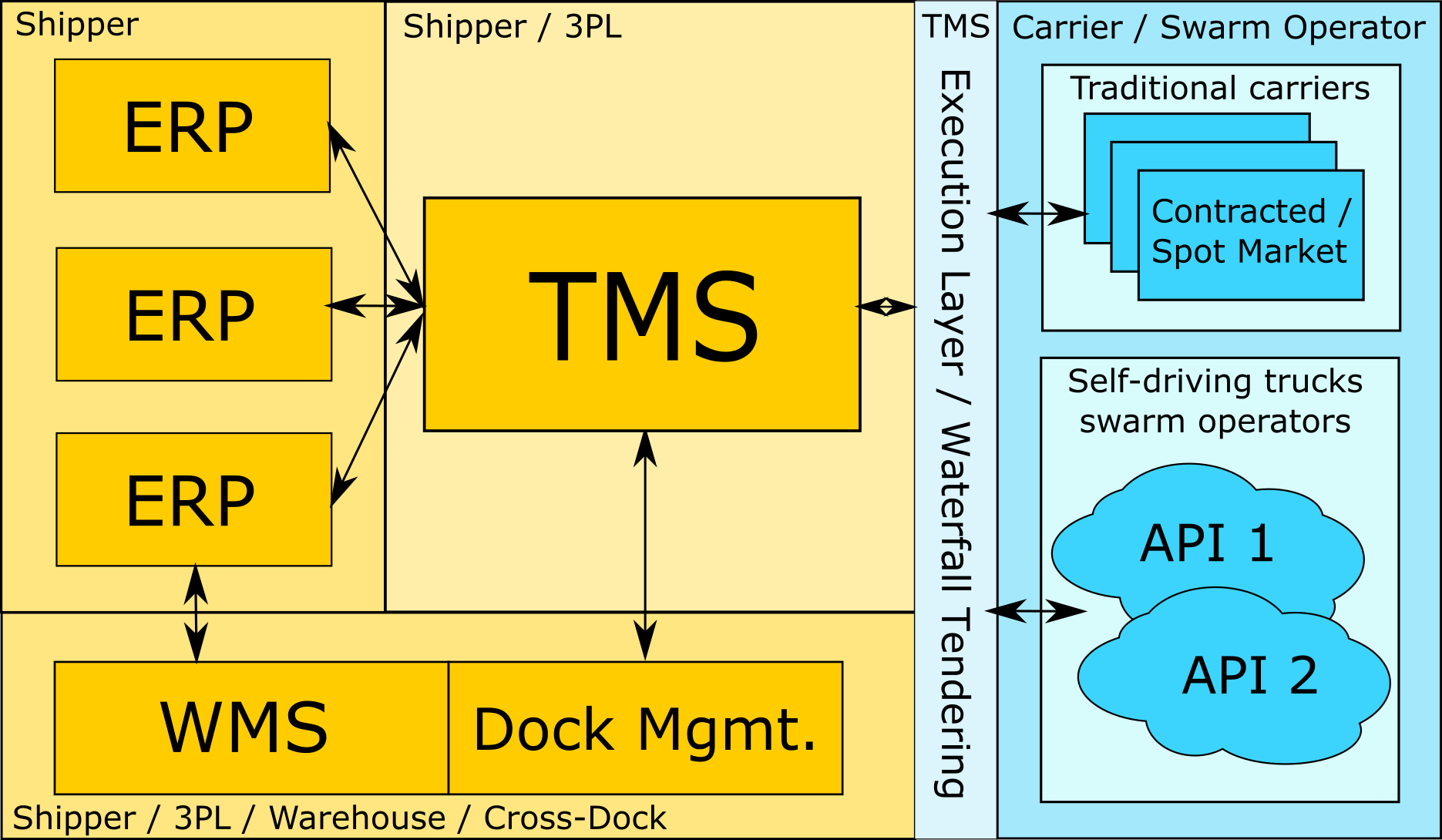It is becoming apparent that the advent of self-driving trucks will radically change the transportation industry. Innovative methods will need to be developed to deal with new challenges related to communications between fleets and shippers or 3PLs.
Traditional “Carriers” will likely become obsolete as companies are forced to change their business models to accommodate new and more stringent requirements for fleet planning and execution.
While public roads and highways are not yet open for autonomous truck, multiple tests are being conducted in the United States as well as Europe and Japan this year. The technology is improving fast and no doubt legislation will soon to follow.
The economic benefits of self-driving trucks are obvious:
• With no driver required, there are no salaries, payroll taxes, pensions, medical insurance or other benefits to be paid
• Without Federal Driver’s Hours regulations, downtime on the road will be minimized
• Without the need to get a driver home, there will be fewer empty miles
• Improved safety both for equipment and cargo will lead to lower insurance costs
• Better fuel economy
To take advantage of the 24/7 capability and to further optimize the supply chain, warehouse automation and docks automation will be required. Automated warehouse management + robo-lumper + self-driving truck solutions ensure uninterrupted operation. A modern TMS will need to have the capability of coordinating an autonomous vehicle with a WMS component.
One distinct feature of self-driving trucks is that they are always connected to both V2V networks and to the internet in general. This means that both the fleet operator and the shipper TMS will always be aware of the truck’s position and speed. This renders obsolete the multitude of currently used tracking services and apps since the TMS is going to receive raw data directly from the truck. Geo-fencing problems will be trivial given the accuracy of the GPS/Glonass combination.
It seems inevitable that during the third phase of deployment there will be state legislation prohibiting self driving trucks on certain roads. This will cause "gaps" in the geography. As a result, there will be a need for special drivers. Just as ships are steered by Panama Canal pilots when passing through the canal, self-driving trucks will pass through restricted areas by utilizing special drivers. These drivers are picked up when entering the area and dropped off when their services are no longer required.
A TMS would be utilized to match available drivers to trucks, coordinate pickups and drop schedules for area border locations.

The Brave New World
What may have sounded like science fiction just a few years ago is about to be deployed nationwide. As soon as self-driving trucks are allowed on all public roads, the structure of the transportation industry is going to be transformed completely. Why is that and what does it mean for the modern Transportation Management System?
“Uber” and “AirBnB” comparisons are overused; however, these are perfect examples of individuals entering markets previously unavailable or available only to a small number of companies. As a result, the world of taxicabs will never be the same. Customers have gotten a taste of affordable and quality service. Consequently, cab companies are on the endangered list of businesses.
Self-driving trucks open another opportunity of this type. With a relatively low investment of $150,000 to $300,000 any individual or small business will be able to buy or lease a driverless truck and make it available for hire. Interestingly, the truck owner may never see the truck they purchased. Once the truck leaves the dealership it may go on the road immediately and start making deliveries. Such tasks as fueling, loading / unloading and maintenance are either automated or outsourced.

Self-driving truck operation is not limited or bound by the location of their owner, therefore they can go from regions with lower profit margins to those with higher margins, ensuring greater competition, capacity availability and true market prices.
In order to participate in such an open market, trucks must belong to a swarm. A swarm is an environment where numerous geographically distributed autonomous trucks announce their position and availability as well as take orders and report statuses. We expect companies like Uber or TruckStop to be swarm operators for self-driving trucks.

The modern TMS has the following means and protocols enabling interaction with self-driving trucks swarm operators:
• The ability to negotiate contract rates with shippers looking for predictable fixed or even discounted rates for a certain period of time.
• The ability to accept shipment orders, as well as manage spot rate quotes from swarm operators.
• The ability to communicate shipment order placement, pickups and deliveries terms.
• The ability to digitally send documentation, and electronically signed bills of lading.
• The ability to digitally transfer escrow and advance payments.
• The ability to coordinate pickups and deliveries with a WMS.
• The ability to track shipment progress.
• The ability to manage exceptions, OS&D, and claims escalation.
• The ability to manage payment processing with swarm operator.
• The ability to manage communication with a private fleet of self-driving trucks.
Many of these functions are utilized when dealing with traditional carriers, but with self-driving trucks there is a lot less paperwork and a lot more electronic data interchange.
When there is no driver to sign for the cargo, there will be a greater emphasis on secure communication, strong cryptography and block-chain technology.
At McLeod FMS we are constantly working on improving our TMS solution. While the future of self-driving technology represents a serious challenge to the trucking industry, with McLeod FMS many of the innovations that will be required are already present and being utilized in a more traditional fashion. As self-driving technology advances we will be keeping an eye on how our software can address the changing needs of an increasingly more technological trucking environment.
For more information on McLeod FMS please contact:
Cody Arnold,
Regional Sales Manager
Email: Cody.Arnold@mcleodsoftware.com
Office Phone: (205) 907-0983